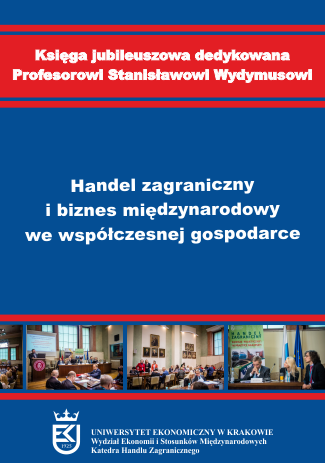Nowe państwa członkowskie UE w procesie doganiania Niemiec

Abstract
W tym opracowaniu analizujemy proces doganiania państw najwyżej rozwiniętych (tu: Niemcy) przez gospodarki nowych państw członkowskich UE (New Member States, NMS): Polskę, Bułgarię, Czechy, Rumunię, Słowację i Węgry. Przedmiotem analizy czynimy więc, najwyżej – naszym zdaniem – w grupie NMS rozwinięte państwa, stanowiące trzon Grupy Wyszehradzkiej (V4), które wstąpiły do UE w 2004 r. oraz słabiej rozwinięte: Bułgarię i Rumunię, których akcesja nastąpiła w 2007 r. Chcemy sprawdzić, jak początkowe stany gospodarek oraz kilkuletnia różnica momentu akcesji wpłynęły na konwergencję ich specjalizacji eksportowej w kierunku wzorca gospodarki Niemiec. Porównanie dotyczy lat 2000-2014. Analizę poprzedzają rozważania nad pojęciem konkurencyjności jako zdolności gospodarki do osiągania celów rozwojowych.
Keywords
konkurencyjność gospodarki narodowej, gospodarki doganiające, nowe państwa członkowskie Unii Europejskiej, zmiany strukturalne
Author Biography
Elżbieta Czarny
Profesor zwyczajny w Instytucie Międzynarodowych Stosunków Ekonomicznych Kolegium Gospodarki Światowej. Zainteresowania naukowe: niedoskonałości konkurencji, rynki międzynarodowe, ryzyko i asymetria informacji w działaniach gospodarczych. Jest jednym z pierwszych w Polsce naukowców, zajmujących się ekonomią sportu. Pokazuje słuchaczom studiów związki między ekonomią i sportem oraz sposoby mierzenia efektywności gospodarczej wydarzeń sportowych.
References
- Aiginger, K., Bärenthaler-Sieber, S., & Vogel, J. (2013). Competitiveness under new perspectives. WWWforEurope Working Paper.
- Atkinson, R. D., & Ezell, S. J. (2012). Innovation Economics: The Race for Global Advantage. Yale University Press.
- Auzina-Emsina, A. (2014). Labour Productivity, Economic Growth and Global Competitiveness in Post-crisis Period. Procedia – Social and Behavioral Sciences, 156, 317-321. https://doi.org/10.1016/j.sbspro.2014.11.195
- Balassa, B. (1965). Trade Liberalisation and “Revealed” Comparative Advantage. The Manchester School, 33(2), 99-123. https://doi.org/10.1111/j.1467-9957.1965.tb00050.x
- Bieńkowski, W., Weresa, M., Czajkowski, Z., Gomułka, M., Brocka-Palacz, B., Latoszek, E., Misala, J. (Red.). (2008). Czynniki i miary międzynarodowej konkurencyjności konkurencyjności gospodarek w kontekście globalizacji – wstępne wyniki badań
- (T. 284). Szkoła Główna Handlowa.
- Bujancă, G.-V., & Ulman, S.-R. (2015). The Impact of the Economic Freedom on National Competitiveness in the Main Economic Power Centres in the World. Procedia Economics and Finance, 20, 94-103. https://doi.org/10.1016/S2212-5671(15)00052-0
- Castellacci, F. (2008). Innovation and the competitiveness of industries: Comparing the mainstream and the evolutionary approaches. Technological Forecasting and Social Change, 75(7), 984-1006. https://doi.org/10.1016/j.techfore.2007.09.002
- Chesnais, F. (1986). Science, technology and competitiveness. STI Review, 1.
- Cho, D.-S., & Moon, H.-C. (2008). From Adam Smith to Michael Porter: evolution of competitiveness theory (Reprinted). New Jersey: World Scientific.
- Ciocanel, A. B., & Pavelescu, F. M. (2015). Innovation and Competitiveness in European Context. Procedia Economics and Finance, 32, 728-737. https://doi.org/10.1016/ S2212-5671(15)01455-0
- Cohen, S. S., & Zysman, J. (1988). Manufacturing Innovation and American Industrial Competitiveness. Science, 239(4844), 1110-1115.
- Delgado, M., Porter, M. E., & Stern, S. (2014). Clusters, convergence, and economic performance. Research Policy, 43(10), 1785-1799.
- Dosi, G., & Soete, L. (1991). Technological Innovation and International Competitiveness. W Technology and National Competitiveness (ss. 91-118). McGill-Queen’s University Press.
- Dosi, G., & Soete, L. (b.d.). Technological Innovation and International Competition. W Technology and National Competition. McGill-Queen’s University Press.
- Erickson, S. G., & Rothberg, H. (2000). Intellectual capital and competitiveness: Guidelines for policy. Competitiveness Review, 10(2), 192-198.
- Fagerberg, J. (1988). International Competitiveness. The Economic Journal, 98(391), 355-374. https://doi.org/10.2307/2233372
- Fagerberg, J., Srholec, M., & Knell, M. (2007). The Competitiveness of Nations: Why Some Countries Prosper While Others Fall Behind. World Development, 35(10), 1595-1620. https://doi.org/10.1016/j.worlddev.2007.01.004
- Fundeanu, D. D., & Badele, C. S. (2014). The Impact of Regional Innovative Clusters on Competitiveness. Procedia – Social and Behavioral Sciences, 124, 405-414. https://doi.org/10.1016/j.sbspro.2014.02.502
- Gugler, P., Keller, M., & Tinguely, X. (2015). The role of clusters in the global innovation strategy of MNEs: Theoretical foundations and evidence from the Basel pharmaceutical cluster. Competitiveness Review, 25(3), 324-340. https://doi.org/10.1108/CR-09-2014-0033
- Herciu, M., & Ogrean, C. (2015). Wealth, Competitiveness, and Intellectual Capital – Sources for Economic Development. Procedia Economics and Finance, 27, 556-566. https://doi.org/10.1016/S2212-5671(15)01033-3
- Huemer, S., Scheubel, B., & Walch, F. (2013). Measuring institutional competitiveness in Europe. CESifo Economic Studies, 59(3), 576-608.
- Huggins, R., & Izushi, H. (2015). The Competitive Advantage of Nations: origins and journey. Competitiveness Review, 25(5), 458-470. https://doi.org/10.1108/CR-06-2015-0044
- Johnston, L. D., & Chinn, M. D. (1996). How well is the United States competing? A comment on Papadakis. Journal of Policy Analysis and Management, 15(1), 68-81. https://doi.org/10.1002/(SICI)1520-6688(199624)15:1<68::AID-PAM4>3.0.CO;2-H
- Krugman, P. (1996). Making sense of the competitiveness debate. Oxford review of economic policy, 12(3), 17-25.
- Martin, R. (2005). A Study on the Factors of Regional Competitiveness. Final Report for the European Commission.
- McDaniel, T. H. (2003). Leveraging human resources and improving productivity: Hungary, Slovenia and Bulgaria. SEER: Journal for Labour and Social Affairs in Eastern Europe, 6(1/2), 143-151.
- Papadakis, M. (1996). Confounding Productivity and Competitiveness: A Rejoinder to the Comment, „How Well Is the United States Competing?” Journal of Policy Analysis and Management, 15(1), 82-88.
- Pelagidis, T., & Mitsopoulos, M. (Red.). (2014). Unlocking Growth: Innovation as a Driver of Competitiveness and Prosperity. W Greece (ss. 85-126). Brookings Institution Press.
- Verner, T. (2011). National competitiveness and expenditure on education, research and development. Journal of Competitiveness, 3(2).
- Vlachvei, A., Notta, O., Karantininis, K., & Tsounis, N. (2016). Factors Affecting Firm Competitiveness and Performance in the Modern Business World. IGI Global.
- Weresa, M. (Red.). (2015). Poland: Competitiveness Report 2015. Innovation and Poland’s Performance in 2007-2014. Warszawa: Warsaw School of Economics Publishing.
- Wysokińska, Z. (1997). Aspekty technologiczne konkurencyjności międzynarodowej Unii Europejskiej oraz Polski. Studia Europejskie (2).
- Wysokińska, Z. (2012). Konkurencyjność w międzynarodowym i globalnym handlu towarami technologicznie intensywnymi (high-tech). Studia Europejskie, 1, 127-146.
- Żmuda M., (2017). Towards A Taxonomy of International Competitiveness, Journal of Management and Business Administration. Central Europe, artykuł w procesie recenzji.
- Żmuda, M., & Molendowski, E. (2016). W poszukiwaniu istoty konkurencyjności gospodarki narodowej: studium interdyscyplinarne. Finanse, Rynki Finansowe, Ubezpieczenia, 81(3), 323-333.